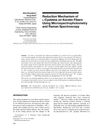TLDR L-phenylalanine and hydrolyzed eggwhite protein deeply penetrate human hair.
The study investigated the penetration of L-phenylalanine (Phe) and hydrolyzed eggwhite protein (HEWP) into keratin fibers of human hair using Raman spectroscopy. It was found that hydrophobic amino acids, like Phe, could penetrate virgin white human hair, while hydrophilic amino acids could not. Phe treatment at 50°C for 16 hours increased its content at various depths of the hair, indicating deep penetration. Similarly, HEWP treatment increased disulfide and random coil contents in bleached human hair, showing that HEWP also deeply penetrated the hair fibers.
 45 citations
,
December 2006 in “Biopolymers”
45 citations
,
December 2006 in “Biopolymers” Permanent waving weakens hair by altering its protein structure.
65 citations
,
May 2006 in “Journal of Structural Biology” Hair curliness is due to uneven distribution of different cortices within the hair fiber.
53 citations
,
March 2006 in “Biopolymers” TTD hair is brittle due to fewer sulfur amino acids and unstable disulfide bonds.
 29 citations
,
August 2005 in “Biopolymers”
29 citations
,
August 2005 in “Biopolymers” L-cysteine slows down the breaking of bonds in hair due to electrostatic interactions.
52 citations
,
February 2005 in “Biopolymers” Chemical hair straightening changes hair proteins and mostly fixes broken bonds.
 16 citations
,
October 2003 in “Journal of applied polymer science”
16 citations
,
October 2003 in “Journal of applied polymer science” 2-iminothiorane hydrochloride improves hair waving permanence without damage.
63 citations
,
December 1998 in “Biochimica et Biophysica Acta (BBA) - Protein Structure and Molecular Enzymology” The study improved understanding of keratin fiber structure by showing consistent microfibril diameter but varying distances and electron density profiles.
70 citations
,
June 1998 in “Polymer” Permanent waving damages hair by disrupting its keratin structure.
36 citations
,
December 1991 in “Journal of Dermatological Science” Human nails contain both skin and hair keratins, each needing different extraction methods.


